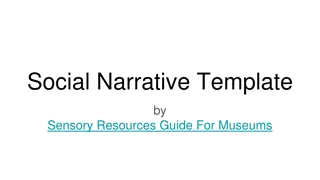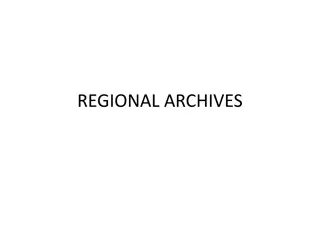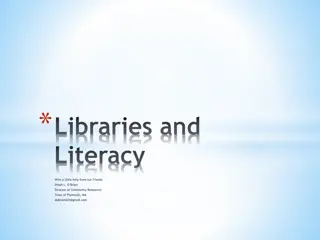Effective Partnerships for Libraries, Archives, and Museums: Building Collaborative Success
Explore the world of library, archive, and museum collaborations through discussions on recent developments, barriers to collaboration, ingredients for success, and advice from industry experts. From cooperation to convergence, learn how to foster effective partnerships and move from coordination to true collaboration.
Download Presentation

Please find below an Image/Link to download the presentation.
The content on the website is provided AS IS for your information and personal use only. It may not be sold, licensed, or shared on other websites without obtaining consent from the author. Download presentation by click this link. If you encounter any issues during the download, it is possible that the publisher has removed the file from their server.
E N D
Presentation Transcript
BETTER TOGETHER Effective Partnerships for Libraries Archives and Museums Jennifer Gunter King, Hampshire College @jgunterking Merrilee Proffitt, OCLC Research @merrileeIam
Library, Archive Museum Collaboration An evergreen topic Robert S. Martin and Margaret Hedstrom 2006 RBMS preconference Silos of the LAMs (2008)
Recent developments Academic Art Museum and Library Summit at University of Miami (2016) Kress+DLF GLAM Cross-Pollinator Awards (2017) 2nd Academic Art Museum and Library Summit at Oberlin College (2018)
Barriers to collaboration Significant differences Training / degree programs descriptive practice systems and standards separate administrative structures Niels Kliim Niels Kliim Wall spikes fence cc-by 2.0
Ingredients for success Deep sharing staff money Shared administrative structures Rod Waddington Rod Waddington Breaking eggs cc-by-sa 2.0
Contact: groups meet, enter dialog and explore common activities and needs Cooperation: informal activity with small but tangible benefit Coordination: beyond ac hoc; calendars, meeting reports, share to-do lists and timelines Collaboration: process of working together creates something that would not be possible with just a single partner Convergence: organizations are entwined. You are in one another s budgets and on each other s org charts. Making the leap from coordination to collaboration is difficult. Making the leap from coordination to collaboration is difficult. The Collaboration Continuum The Collaboration Continuum. Zorich, Diane, Gunter Waible, Ricky Erway. 2009. Beyond the Silos of the LAMs: Collaboration Among Libraries, Archives and Museums. Dublin, OH: OCLC Research
Advice from the trenches Don t worry about metadata mapping indexing data is no longer a problem the web has shaped behaviors Open source software and IIIF help ( cross community collectives ) Focus on opportunities with particular disciplines Have coffee with your colleagues (regular scheduled meeting help, too) Ride on the coattails of curators who have responsibility for faculty engagement New library or museum staff hires as an opportunity for a reset Change agents can t be polarizing forces
Advice for archivists What are mission drivers for GLAM collaboration? Shared storage needs? Serving research needs? Serving teaching needs? What are administrative structures? Are the library and the museum under the same provost? Establish standing committee around shared goals Who are potential change agents? Can you leverage staff that are new to the organization?
Particular opportunities for library- archive collaboration? CONVERGENCE OF SPECIAL COLLECTIONS AND THE RESEARCH LIBRARY Research libraries are increasingly recognizing a convergence of collections, services, goals, and skill sets across both general and special collections. In the last several years, the intersection of the growth of computational scholarly research methodologies and outputs, growing collections of research data sets, and an increased interest in collecting ephemeral and grey literature, have shifted collecting such that many recent additions to library collections look much more like special collections. They are often contextually situated objects coming in through nontraditional channels or in digital formats that have urgent preservation needs. Weber, Chela Scott. 2017. Research and Learning Agenda for Archives, Special, and Distinctive Collections in Research Libraries. Dublin, OH: OCLC Research. doi:10.25333/C3C34F.
A case study of collaboration - Five Colleges (FC) & Museums 10 (M10) The Five Colleges, formally established in 1965 as a consortium, includes - Amherst College, Mount Holyoke College, Smith College, the University of Massachusetts Amherst, and later Hampshire College Museums10 is a collaboration of seven campus museums and three campus-affiliated museums - Beneski Museum of Natural History, Amherst College; Emily Dickinson Museum; The Eric Carle Museum of Picture Book Art; Hampshire College Art Gallery; Historic Deerfield; Mead Art Museum at Amherst College; Mount Holyoke College Art Museum; Smith College Museum of Art; University Museum of Contemporary Art; Yiddish Book Center
Making the leap from coordination to collaboration is Making the leap from coordination to collaboration is difficult difficult . and benefits from experience, shared goals and mission, and the belief that working together gets us further than working on our own. The Collaboration Continuum The Collaboration Continuum. Zorich, Diane, Gunter Waible, Ricky Erway. 2009. Beyond the Silos of the LAMs: Collaboration Among Libraries, Archives and Museums. Dublin, OH: OCLC Research
FC & M10 coordination Library Committees Access, Discovery, Innovative Learning, User Experience, Archives and Special Collections, Digital Stewardship, along with working groups With general charges to share best practices, be forward thinking Products: Digital Preservation: A Planning Guide for the Five Colleges Annual Five College Libraries All Staff professional development Museum Committees Education, Curators, MIMSY, Diversity Products: Annual Museums 10 Professional Development Event Sharing/Developing Best Practices
FC & M10 collaboration FC library collaborations (not an exhaustive list) Five College Annex and Depository: storage for print monographs and journals EAST Eastern Academic Scholars Trust - shared print archive retention agreements The Five College Archives Digital Access Project digitized collections relating to women's history and education Five College Finding Aids Project - a searchable database of finding aids for archives and manuscript collections. Museum collaborations Collaborative Programming that expands beyond Museums to include Libraries, Archives and Special Collections Go Dutch Books to Blogs and Back, 2007 Food
FC & M10 convergence Shared Integrated Library Service Triple III Aleph FOLIO Shared Museum Collections Management & Discovery Software MIMSY/MOBIUS
Advice to archivists Explore perceived differences across professions Collaboration in traditional realms in the Five Colleges has been easier than pursuing collaboration in new and emerging realms Frameworks for Distributed Responsibility Frameworks for Distributed Responsibility If responsibility for born-digital collections is to be truly and appropriately distributed across our programs, it is important to consider what skills and roles might be needed to operationalize shared responsibility, how to create networks and support systems for positions expected to be change-agents, and what ongoing leadership support is required to effect programmatic change. Weber, Chela Scott. 2017. Research and Learning Agenda for Archives, Special, and Distinctive Collections in Research Libraries. Dublin, OH: OCLC Research. doi:10.25333/C3C34F.
Future developments Five College Libraries, Museums and Collections Summit (October, 2018)























